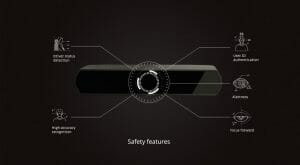EN



When we talk about how Driver Monitoring Systems (DMS) have revolutionized safety in the automotive industry, we sometimes tend to overlook a large chunk of the vehicles currently on our roads: fleets. Millions of the cars, trucks, and buses we benefit from every day are driven by people who spend their days in one of the most high-risk professions around.
At most jobs, you can afford to have an off day every now and then. Whether you had trouble getting to sleep the night before or find yourself getting sidetracked by something that happened earlier that morning – you can most likely make up for it the next day. This isn’t the case for professional drivers. At 60 miles per hour, a bad night’s sleep or a distracting phone can make the difference between life and death.
The average fleet driver is involved in 4.5 road accidents every year. Crashes with commercial vehicles are not just frequent, they also carry irrevocable consequences. Out of approximately 450,000 police-reported crashes in the US involving large commercial trucks in 2017, 4,237 were fatal and 344,000 resulted in injuries.
The rapid adoption of advanced driver monitoring systems in new cars has already brought about a shift in road safety, offering an unparalleled level of protection for both drivers and the public. But drowsiness and distraction can occur in all drivers, in every type of vehicle. That’s why technology that monitors the driver’s state and behavior is just as important in the millions of trucks, buses and cars already on the road.
Driver monitoring systems act as vigilant guardians – driver support systems that continually observe and analyze driver behavior to identify and prevent potential risks. Using advanced technologies such as cameras, sensors, and machine learning algorithms, DMS can detect signs of fatigue, distraction, and other risky activities.
The advantages of DMS technology extend across various fleet and commercial vehicle sectors. For instance, in the transportation and logistics industry, where timely deliveries are crucial, DMS helps ensure driver alertness, reducing the likelihood of delays or accidents caused by fatigue. And, where it involves the transportation of hazardous goods, DMS helps avoid accidents that are hazardous to road users and the environment alike. Similarly, in the passenger transport industry, such as buses and taxis, DMS can enhance passenger safety and promote safe driving practices.
Today’s driver monitoring systems can be designed with data privacy in mind. To support fleet drivers in safer driving behaviors it is not necessary to record video of the driver. DMS systems, like Smart Eye’s AIS, can run in real time on device and just record metrics reflecting driver behavior, without ever recording or storing a video or image of the driver. We will talk more about how DMS works and the ethics and privacy considerations in an upcoming blog.

Distracted driving has emerged as the number one cause of preventable fleet crashes. Whether it’s the temptation to check a mobile device, eat while driving, or engage in other non-driving activities, distractions pose a significant threat to road safety. Driver monitoring systems play a pivotal role in addressing this issue by analyzing driver behavior and detecting potential distractions in real-time. Through audio and visual alerts, DMS can remind drivers to refocus their attention, significantly reducing the risks associated with distracted driving.
Fleet drivers, often subjected to demanding schedules, long-haul drives, and night shifts, are also particularly susceptible to fatigue-related risks. By monitoring key indicators such as eye movements, head positioning, and microsleep episodes, DMS technology becomes an invaluable ally in combating driver fatigue. By promptly identifying signs of drowsiness, the system can alert drivers, facilitating rest breaks or necessary driver rotations, effectively reducing the likelihood of accidents caused by fatigue.
Driver monitoring systems are a game-changer for enhanced fleet safety. With the ability to monitor driver behavior, DMS technology represents a critical safety net for fleets and commercial vehicle operations.
In a world where fleets and commercial vehicles play an integral role in our daily lives, the implementation of driver monitoring systems is no longer a luxury; it is an imperative. This is also highlighted by regulation and ratings agencies such as Euro NCAP requiring DMS for fleets. Thanks to advancements in technology, we can look toward a future where fleet safety is paramount, accidents are minimized, and lives are safeguarded – paving the way for a safer and more responsible fleet industry.
Learn more about Smart Eye’s complete Driver Monitoring System (DMS) for fleets or contact us today to schedule a demo!
